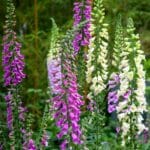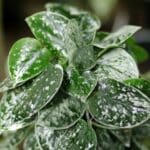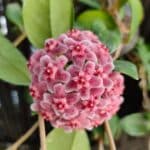Are you thinking of growing Plumosa Fern? By all means, you should! This perennial plant is a very beginner-friendly houseplant and will definitely add beauty to your space.
The plant is loved for its ornamental attributes, accentuated with its long, soft leaves that grow like feathery clumps. Taking care of this plant is quite straightforward. You need to plant it in nutrient-rich, well-drained soil, water regularly to remain moist, and apply a balanced fertilizer monthly.
This post will cover all the basics of plumosa fern care and growing conditions, such as propagation, repotting, pruning, management of pests and diseases.
Table of Contents
What Is Plumosa Fern?
Before getting into the care guidelines of this plant, we must familiarize ourselves with some basic information about this plant.
The plumosa fern’s origin can be traced to South and East Africa. Even though it has the word ‘fern,’ it is not classified as a fern. It gets its name because the leaves are fern-like.
Also, this plant is not classified as a fern because while fern produces spores, plumosa fern produces flowers and seeds.
This plant belongs in the Asparagaceae family and shares a close resemblance with lilies. Plumosa fern also goes with names like lace fern, climbing asparagus, asparagus grass, or ferny asparagus.
The botanical names Asparagus setaceus, Asparagus plumosus, and Protasparagus setaceus are sometimes used to refer to this plant.
This might be a misnomer since these botanical names refer to plants that share some common attributes with asparagus fern or plumosa fern.
All Plumosa ferns leaves have a type of cladode that helps carry out photosynthesis. The cladode is a flattened stem that looks like a leaf.
As mentioned, plumosa fern produces flowers and seeds. These flowers come in white, small clusters and can go unnoticed for some time. After flowering, asparagus ferns produce small red berries that contain seeds.
In some countries, plumosa ferns are referred to as a weed probably because of their invasive nature.
Yes, this plant can easily take over your backyard, especially in warm temperatures. To prevent this, grow plumosa fern in pots outdoors to prevent them from becoming invasive.
Read Also: Philodendron Red Moon Care
Plumosa Fern Care and Growing Conditions
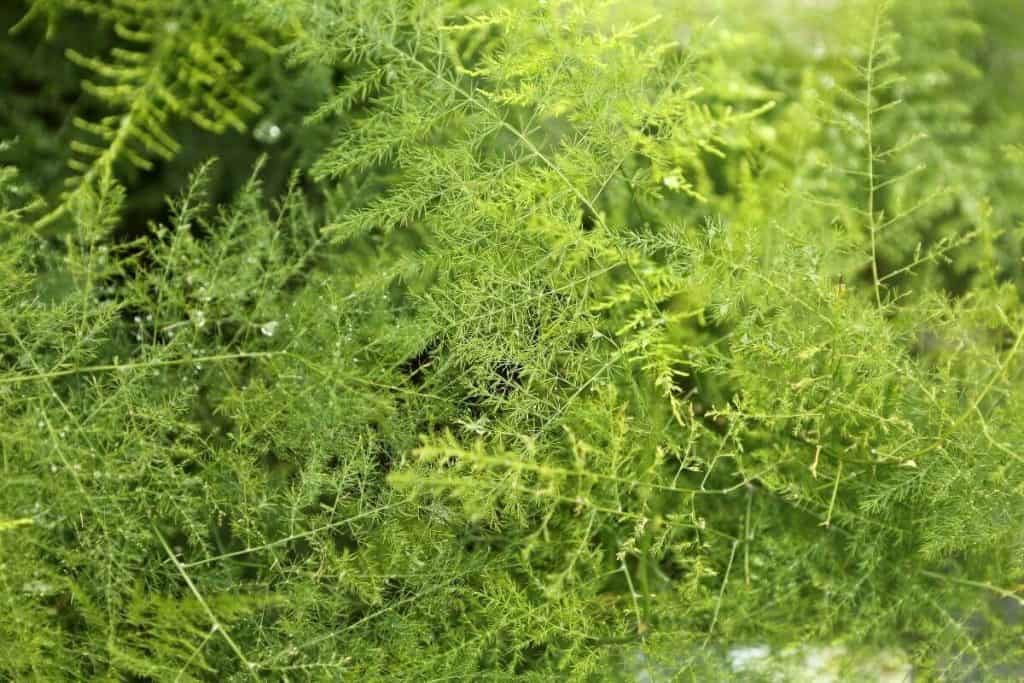
As mentioned earlier, these plants are quite easy to care for and thus are beginner-friendly. They need to be planted in fertile, loose, well-draining soil and watered frequently to prevent the soil from drying out.
Now, let's get into particulars about the care guidelines for plumosa Fern.
Plumosa Fern Light Requirements
While it is recommended that these plants be grown outdoors because of their invasive nature, the plumosa fern will get the ideal light condition indoors.
This plant thrives best in partial shade and at most should be subjected to 2-3 hours of direct sunlight a day.
Too much direct sunlight can dry out the soil too fast, scorch the delicate foliage, and stress the plant. Also, too much direct sun can cause yellowing of the leaves.
To get the best result, grow this plant in a bright room. If the room doesn’t get enough natural light, you can use an artificial light source.
Alternatively, place the plant on a north-facing or east-facing window where the plants will get plenty of morning sunshine.
Plumosa Fern Soil Requirements
Like every indoor plant, Plumosa Fern needs good garden soil made up of organic matter like peat moss or perlite and sand when planted indoors. This mixture in equal proportions will give you a well-draining and fertile potting mix.
Organic matter like peat moss or perlite allows excess water to drain freely and helps retain just the right amount of moisture.
The pot should have drainage holes. This is to prevent the potting soil from being too sogging, which will eventually lead to the rotting of the roots.
Notably, Plumosa Fern can literally survive in any soil type, but you want to grow this plant in a rich, fertile potting mix to get the best result.
Plumosa Fern Water Requirements
As mentioned earlier, plumosa ferns need to be watered regularly so that the soil doesn’t completely dry out. The plant should be watered when the topsoil is dry. Make sure that the water touches the root and drains out the bottom.
Below are some tips to help you water your Plumosa Fern accurately:
- Don’t splash water on the Leaves: watering the leaves while watering this plant will promote fungi growth. Only water the soil when it is dry.
- Water new transplanted Plumosa Fern Daily: for newly transplanted Plumosa Fern, you may need to water daily for 2-3 weeks consecutively until a watering schedule is fully established.
- Water according to soil type used: as already emphasized, plumosa fern should be planted in a well-draining and fertile potting mix. But since this plant can practically survive any soil type, if it is planted in soil that retains water (like loamy soil), you don’t need to water frequently.
- Drench the soil thoroughly when watering: the best way to water Plumosa fern is to drench the soil thoroughly, allowing the excess water to drip out from the drainage holes (this is why the drainage holes are essential).
- Water with good quality water: Rainwater is best recommended for Plumosa Fern. Since you can always get rainwater, you can alternate with filtered tap water. Ensure that tap water does not contain high concentrations of salt.
- Establish a watering schedule: once the newly transplanted plant is established, you must adopt a watering schedule. You must maintain equal intervals between days of watering and not watering.
Plumosa Fern Temperature Requirements
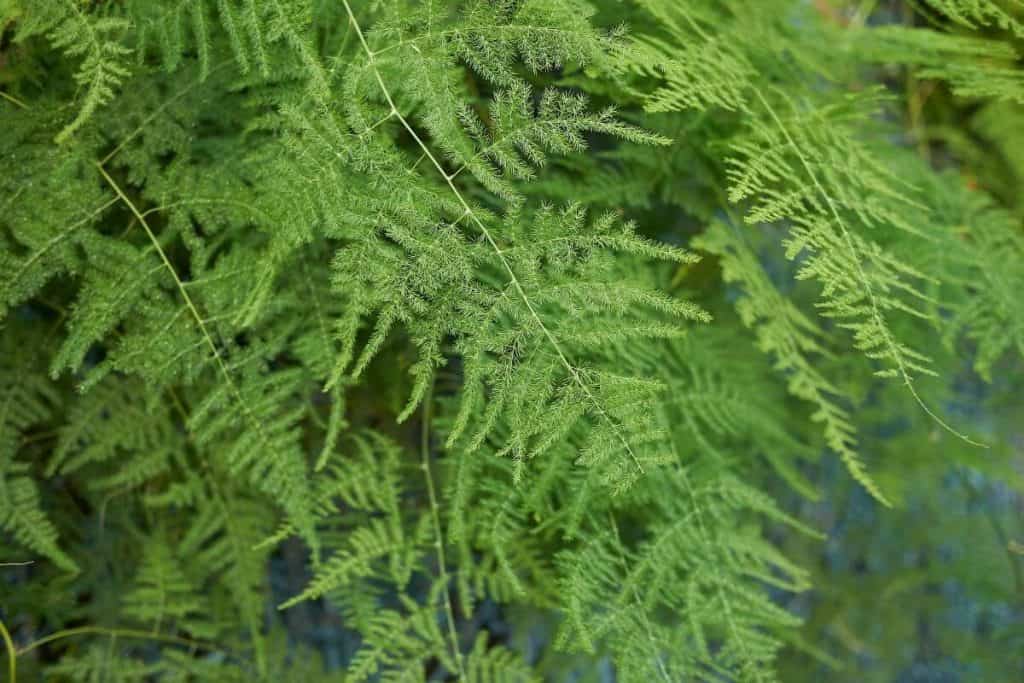
The temperature requirement for Plumosa Ferns grown outdoors should differ from when it’s grown indoors. Outdoors, the average temperature should be around 70°F (21°C) and indoors should range from 65°F to 70°F (18°C – 21°C).
Plumosa Ferns should be protected from extreme temperature. They should be kept away from direct sunlight and out of drafts.
In colder temperatures, you can grow this plant outside to add a greenery beauty to your patios, deck areas, or balconies. For hot temperatures, the plant should be taken inside so you can control the temperature.
An air conditioner can be used to help alleviate the hotness providing a cooling effect on the plants. The plant should also be misted when the environment gets very dry. Note that these plants can grow in temperatures below 55°F (13°C).
Read Also: Types Of Carnivorous Plants
Plumosa Fern Humidity Requirements
Plumosa ferns thrive beautifully in humid conditions; thus, you need to mist the plant in dry environments. The humidity level for Plumosa Ferns should be above 70%. If the humidity level is below this, you can add a humidifier to add moisture to the air.
While misting is recommended in dry weather, it can be a bit tedious. There are other laid-back approaches you can adopt to keep the humidity condition ideal for your Plumosa Fern:
- Use a pebble tray filled with water: this can drastically raise the humidity level of the plant. Simply put decorative pebbles in a deep tray and pour in enough water halfway up the stones. Place the plant on the pebbles, ensuring that the container doesn’t sit in water.
- Group the plants: grouping plants with similar humidity needs is another way to raise the humidity level. This approach might also need you to additionally mist the plant.
- Use a Room humidifier: as mentioned, a humidifier can increase humidity for moisture-loving houseplants like plumosa ferns.
Plumosa Fern Fertilizer Requirements
Generally, plumosa ferns can survive without fertilizers. But to keep the leaves green and healthy, you may need to apply fertilizer during the growing season.
Liquid fertilizer should be applied monthly from spring to fall to encourage lush, healthy growth. If Liquid fertilizer is not readily available, use a slow-release granular fertilizer.
Excessive fertilizing may encourage the growth of mineral salts in the potting soil. To prevent this from happening, water the plant for two minutes straight and allow all the excess water to drain out. Once this is done, you can resume fertilizing the asparagus fern as usual.
Trimming/Pruning Plumosa Ferns
Remember that we mentioned that plumosa ferns could be quite invasive. However, this can be controlled if it is planted in pots. For dead or yellow leaves, prune them to control the plant’s growth and encourage healthy growth.
When pruning or trimming Plumosa Ferns, follow the steps below:
- Wear protective gloves; sometimes, the older plants can develop thorns under the thick foliage.
- Use sharp, sterilized pruning shears to cut back old plumosa stems
- To encourage healthy growth, pinch the off the stem tips
- Always prune off yellow or brown stems
- Cut off long stems to help keep the compact shape of the plant.
How to Repot Plumosa Ferns
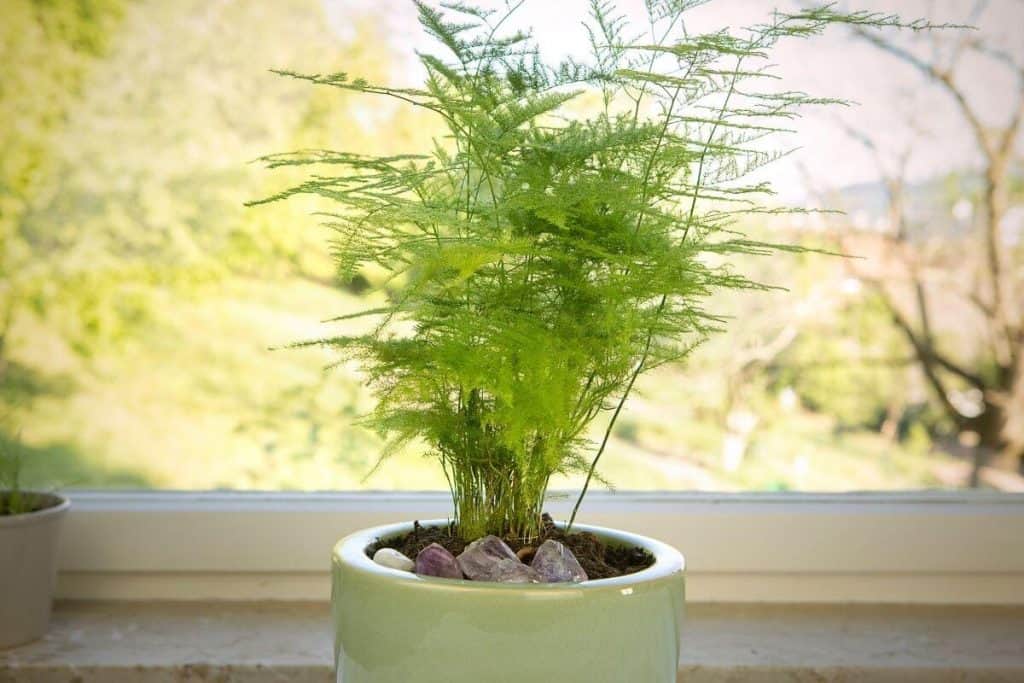
Plumosa ferns need to be repotted at least every spring. Signs that your plumosa ferns need to be re-potted as soon as possible include when the roots start to poke out of the drainage holes and water starts taking time to drain out.
This may cause the plant to become rootbound and cause root damage.
Follow the steps to repot your plumosa fern:
- Carefully remove pull out the plant from its container.
- Shake off the excess soil that sticks to the plants or carefully dislodge the soil with your hands.
- Check the roots for signs of damage and trim out any roots that look brown and mushy.
- Get a pot or container that is one size larger than the current one and fill it halfway with a light potting mix.
- Put your asparagus fern in the pot and fill it with more soil.
How to Propagate Plumosa Ferns
The best way to propagate plumosa ferns is by using the root division method. Before embarking on this type of propagation, ensure that the tuber root sections have plenty of shoots. Plant the newly separated piece in new pots or partially shaded areas of your garden.
Follow the steps to propagate your plumosa fern using the root division method:
- Pull off plumosa plant from its container and dislodged the soil clinging to the roots.
- Use a clean, sterilized knife to cut through the tuber root.
- Plant the separated piece in a suitable pot and water thoroughly.
Common Pests that Affect Plumosa Fern
The good thing about this plant is that it is rarely affected by pests. Sometimes, pests like mealy bugs, spider mites, and scales can affect plumosa fern.
Thus, there is a need to examine the plant closely to ensure that there is no pest infestation. Pests like mealybugs are quite easy to detect owing to their cotton-like structures and color. They usually appear on the surface of the leaves or stems.
For pests like spider mites, detecting them is very difficult because they’re very subtle. They attack new leaves and buds until nothing is left of the plant.
Scales multiply so fast before you even notice them.
The best way to deal with these pests is by applying neem oil on the plants. Combine 1.5 tsp. organic neem oil and 1 teaspoon of mild dish soap with 33 fl. oz. (1 l) of warm water. Pour into a spray bottle and spray on your plants to get rid of pests.
If the infestation is not too severe, manually remove the pests by spraying water on them. for severe pest infestation, isolate infected plants to avoid these insects from transferring to another host and treat the infested plants with chemical pesticide
Diseases that Affect Plumosa Fern
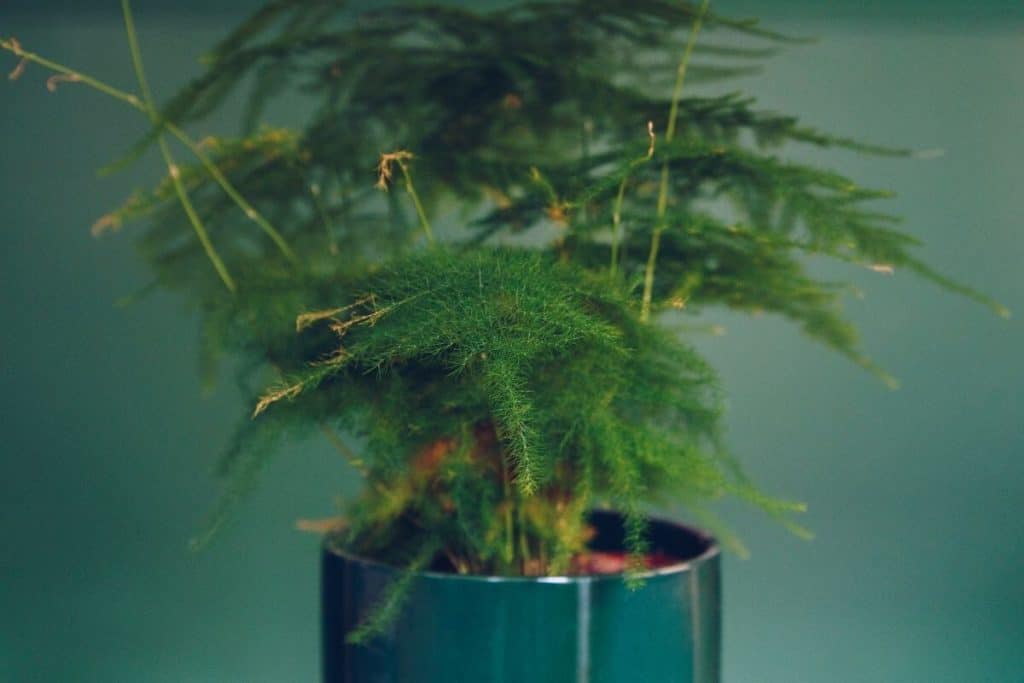
The most common disease that affects plumosa fern is fungal root rot. This mostly happens when you overwater the plant. Only water the plant when the topsoil is partially dry and ensure that water drains freely from the pot.
Overwatered plumosa fern signs include yellowing leaves, wilting growth, and red discoloration on the stalk bases.
Read Also: How to Care for Blue Plumbago Plant
Frequently Asked Questions
How Much Light Does a Plumosa Fern Need?
For direct sunlight, place this plant in a spot that receives at least 2-6 hours of direct sunlight. Excessive sunlight can dry out the soil too fast, scorch the delicate foliage, and stress the plant. Also, too much direct sun can cause yellowing of the leaves.
What Is Plumosa Fern Used For?
Plumosa fern is usually used for ornamental purposes. It makes a perfect indoor plant and can be grown in pots and containers. Plumosa ferns also make excellent hanging plants and are grown in hanging baskets and combination planters. Their fern-like nature also makes them a perfect small-scale groundcover plant.
Are Plumosa Ferns Toxic?
Plumosa ferns are poisonous to cats and dogs. Thus, is it might not be such a good idea to grow this plant if you have pets in your home. Signs that your cat, dog, or pet has ingested parts of the asparagus fern are vomiting, dermatitis, abdominal pain, or diarrhea.

